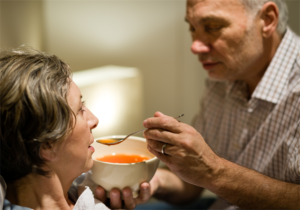
Credit: ehospice.com.uk
Caring for a loved one with a terminal illness is exhausting and isolating. In many cases, caregivers are forced to quit their jobs and deplete their savings in order to care for an ailing family member in the home. According to the Caregiver Action Network, caregivers and their families are more likely to live in poverty than their non-caregiver counterparts. And many rely on Supplemental Security Income to meet their financial needs. An overwhelming majority also report skimping on sleep, diet, exercise and visits to their own doctor due to the time involved in attending to their loved one’s needs.
It should come as no surprise, then, that caregivers are subject to higher rates of depression and anxiety than the public at large. Yet, according to Debra Parker-Oliver, Ph.D., a professor in the Department of Family and Community Medicine at the University of Missouri School of Medicine, health care providers are not assessing this vulnerable population for mental health problems as thoroughly as they should.
“We have a population that is under immense stress and is not being acknowledged,” she said. “Basic assessment tools should be used to help increase the likelihood of early detection and treatment of depression and anxiety in family caregivers.”

Credit: evidentlycochrane.net
Parker-Oliver was the lead investigator in a study conducted at the University of Missouri last year. Her team of researchers looked at the prevalence of depression and anxiety in 395 individuals who were caring for a terminally ill family member in the home. Published in the Journal of Palliative Medicine in December, 2016, the study showed that nearly one in four caregivers suffered from moderate to severe depression. Additionally, about one-third of the subjects had moderate to severe anxiety.
The study also identified a number of risk factors that increased the likelihood that a caregiver would become anxious or depressed. For example, younger caregivers suffered more mental health issues that older ones. And spouses caring for a loved one with a diagnosis other than cancer, such as Alzheimer’s disease, had a higher incidence of depression than other subjects.
Healthcare Workers Focus on the Patient
There are likely a number of reasons why caregiver depression and anxiety go unnoticed. Parker-Oliver believes that a major factor is that hospice providers focus on the patient rather than the family’s needs. Or they may notice the caregiver’s distress, but don’t intervene because the caregiver is not their patient — the dying person is. But, she adds, “In many scenarios, it is a family disease. It’s fair to say they have two patients: the caregiver and the person who is terminally ill.”
There are currently 34 million Americans partnering with hospice to care for dying loved ones in the home. Early mental health screening for family caregivers would allow for early intervention and greater psychosocial support for those at risk, Parker-Oliver believes.

 Caregivers Rarely Screened for Depression and Anxiety, Study Shows
Caregivers Rarely Screened for Depression and Anxiety, Study Shows



 “As Tears Go By” by Marianne Faithfull
“As Tears Go By” by Marianne Faithfull
 “The Sea” by John Banville
“The Sea” by John Banville














